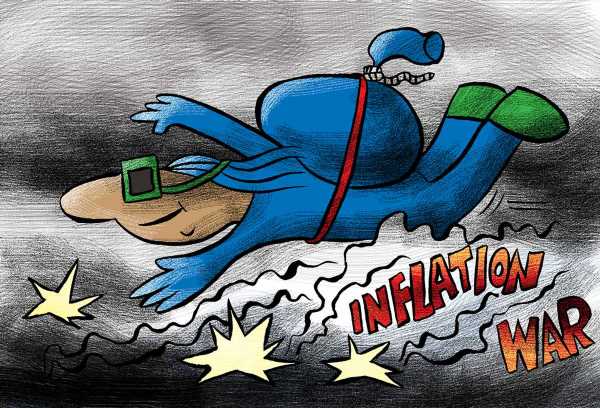Many investors want to exit equities now and re-enter when they begin to rise. Such timing is difficult to pull off.
After two years of blockbuster returns in 2020 and 2021, most equity mutual fund categories have given single-digit or negative returns in 2022.
Their lacklustre performance may continue for some time in 2023 as well.
Indian equity funds, however, were spared the carnage seen globally.
“Global challenges like higher inflation and interest rates, higher energy costs due to the Russia-Ukraine war, and growth concerns across US, Europe and China impacted equity sentiment. Global investors reduced equity allocations leading to a sharp correction across key markets globally. The Indian market, however, displayed remarkable resilience and was among the year’s better-performing ones,” says Sailesh Raj Bhan, deputy chief investment officer-equity investments, Nippon India Mutual Fund.
Large-cap funds: Better suited to turbulence
Large-cap funds have given a category average return of 0.07 per cent year-to-date (YTD) in 2022, compared to 14.2 per cent in 2020 and 25.9 per cent in 2021 (data as on December 23).
The longer the the global headwinds continue, the greater could be the impact on India’s growth possibilities.
In such an environment, investors would be better off having a higher exposure to large-cap funds, which are more resilient.
“Large-cap funds focus on market leaders and established businesses that have successfully navigated different market cycles. These businesses appear well placed in the current context of robust domestic growth possibilities and a weakening global macro-economic environment,” says Bhan.
A large number of large-cap active funds, however, are unable to beat their benchmarks.
“On an average, 60 per cent of the average large-cap fund’s portfolio is similar to the index. With a differentiated portfolio of only 40 per cent, these funds find it difficult to cover the expense ratio and also provide outperformance,” says Arun Kumar, head of research, Fundsindia.com.
In future, they will have to reduce their expense ratios or build more differentiated portfolios.
“A differentiated portfolio, however, will lead to periods of both stark out- and underperformance vis-a-vis the benchmark. The smoothness in returns, a hallmark of this category, could be lost,” says Kumar.
Hence, he adds, there is a compelling case for investing in a passive fund in this category.
Mid-cap funds: Earnings downgrade may take a toll
After two blockbuster years — 23.6 per cent category average return in 2020 and 43.8 per cent in 2021–mid-cap funds have given -1.1 per cent YTD in 2022.
The Nifty Midcap 150 Total Return Index (TRI) has given 3.1 per cent YTD.
Fund managers say this is much better than the performance in many global markets.
“The mid-cap index is focused on domestic economy-oriented sectors like consumer durables, capital goods, banking, etc, which have gained from the ongoing recovery,” says Niket Shah, senior vice president and fund manager, Motilal Oswal Mutual Fund.
Shah expects the mid-cap index to correct over the next six months.
“About 65-70 per cent of companies in this index reported an earnings downgrade in the previous quarter. This is likely to continue in the current quarter. Inflation will take a toll on growth,” says Shah.
Premium valuations are another impediment. “The mid-cap index is trading at 24x one-year forward earnings, much higher than the five-year average of 21x and 10-year average of 18.5x,” says Shah.
If inflation cools and central banks, including the RBI, cut rates in the second half of 2023, mid-cap funds may revive.
Small-caps: In correction mode
After providing average returns of 30.4 per cent in 2020 and 62.6 per cent in 2021, small-cap funds have yielded -3.1 per cent YTD.
“The overall market is undergoing consolidation and the small-cap segment is no different,” says Chandraprakash Padiyar, senior fund manager, Tata Mutual Fund.
The category could continue to face headwinds in 2023.
“Global growth is likely to slow down. This will have some impact on the Indian business environment. The near-term outlook for the overall equity market is range bound with a negative bias. Though valuations within the small-cap category are reasonable, its performance is likely to be similar to that of the overall market,” says Padiyar.
The segment’s earnings growth outlook remains decent.
“If the market corrects sharply, it will provide long-term investors the opportunities to deploy additional capital,” adds Padiyar.
Stay invested
Many investors believe 2022 was a highly volatile year.
“But since the Sensex’s inception, an intra-year fall of 10-20 per cent has happened almost every year, barring three or four,” says Kumar.
Hence, be prepared for volatility in equities.
Many investors want to exit equities now and re-enter when they begin to rise.
Such timing is difficult to pull off. One reason is there are several false rallies prior to the one that sustains.
The market also tends to move up while the news flow is still negative. Investors who exit now risk being left behind when it recovers.
In 2022, funds having a value or contra style performed better than those following the quality and growth styles. In 2020, it was the opposite.
“Don’t move from quality funds to value funds now. It is difficult to figure out which style will perform at what point.
Once you have picked a style, stick to it for 7-10 years,” says Kumar. Also, diversify across styles.
Maintain 15-20 per cent exposure to international funds and 20-30 per cent to mid- and small-cap funds (risk appetite permitting) despite their poor performance this year.
- MONEY TIPS
Source: Read Full Article


